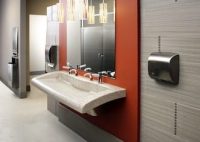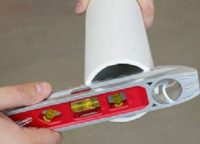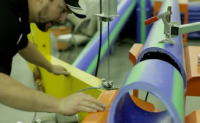Mobile workplaces are becoming more and more prevalent for businesses, including plumbing companies. For example, plumbing techs are using their mobile devices to keep track of calls and emails on their smartphones. As a result, they don’t have to check in with dispatchers nearly as often. While there are plumbers who resist technological encroachment on Read more
Articles

Mobile workplaces are becoming more and more prevalent for businesses, including plumbing companies. For example, plumbing techs are using their mobile devices to keep track of calls and emails on their smartphones. As a result, they don’t have to check in with dispatchers nearly as often. While there are plumbers who resist technological encroachment on their operations, many others remain intrigued.
The Benefits of Mobility
Regardless of a plumbing company’s size, there is a very good chance it can benefit from mobile workplace technology. Owners can track the number of clients and document employee workloads on their smartphones, tablets and laptop computers — saving time and energy.
While mobile technology can make life easier for all employees, it can be especially beneficial for a company’s sales force. If room in the office is at a premium, for instance, sales professionals can use technology to conduct business at a variety of locations. This eliminates the need to reserve conference room space for the next big sales meeting and could substantially increase productivity.
Another benefit is reducing the need for cubicles and other dedicated workspaces. This, of course, can be a huge expenditure — according to an article by agilquest, it costs anywhere between $10,000 to $15,000 to accommodate an office worker. Purchasing the tools needed to implement a mobile workplace program can be pricey, but that cost can be offset long term. In many instances, equipment expenses can be surprisingly minimal — since many techs and other employees already have tablets and smartphones.
Streamlining Operations
It’s not uncommon to find issues with managing and distributing resources in many smaller plumbing operations. One of the main reasons is the continued reliance on logbooks, spreadsheets and other paper-based systems. Mobile technology can help replace these outmoded approaches, improving efficiency and increasing cost savings in the process.
Savvy business owners are using mobile workplace technology to engage with customers through social media platforms and even mobile point of sale applications. A wide range of sophisticated applications are much more affordable than they were just a few years ago, when they were out of reach for most small companies.
Mobile technology also helps to improve and refine workflow, allowing remote employees to provide real-time input through applications such as Skype or WebEx, which are commonly used to arrange online meetings. It also helps salespeople while on the road when meeting with present and future customers.
Addressing Concerns
While the benefits of mobile workforce technology are plentiful, implementing a company-wide program isn’t without its challenges. There could be company culture issues, as some employees used to doing business a certain way may be resistant to change, at first. In addition, mobile phone plans often carry costly hidden charges.
And, of course, security of critical company and customer data will always be a concern. But no challenge is insurmountable as long as the business employs effective protocols regarding information management.
A recommended starting point to putting a strong security program in place is to make sure there is a clear understanding of what kind of data could be exposed, such as customer credit card numbers, trade secrets and possibly even patents. It is critical that a security framework is established that addresses all possible risks.
Plumbing companies should also look closely at how employees use mobile workforce technology, both on and off the job. Limit network access to a certain number of devices, and do not allow additional ones without approval. Establish not only where corporate-related data is allowed to reside, but also mechanisms to enforce standards and controls.
Partnering with a company that specializes in providing technology security solutions will help ensure that data remains as safe as possible.
It is extremely important to always keep in mind that the successful implementation of any security strategy will depend on total employee compliance. It will very likely take time to make sure employees know the best practices regarding mobile workforce technology. But while issues may arise, they can be overcome through the proper amount of training.
An Even Playing Field
Implementing mobile workforce technology may mean dragging some employees kicking and screaming into the 21st century, but it could also mean huge benefits in the long run. As the cost of technology continues to fall, many smaller plumbing companies are putting it to use — finding it helps them compete with larger businesses across select industries. There will be challenges, but by embracing mobility a company can improve processes as well as productivity, possibly increasing revenues as well.
Cheryl Bikowski is the Marketing Communications Supervisor at Gamber-Johnson. Located in Stevens Point, WI, Gamber-Johnson is one of the leading suppliers of rugged computer mounting systems and mobile workplace technology solutions, and is also a member of the Leggett & Platt Commercial Vehicle Products (CVP) Group.

I have the benefit of traveling all over North America, from the East coast to West coast, including Canada. So I have the 30,000-foot view of dealers and critical components of success. I see a few major traits that are common to successful dealers; by successful I mean they are growing their customer base and Read more
I have the benefit of traveling all over North America, from the East coast to West coast, including Canada. So I have the 30,000-foot view of dealers and critical components of success. I see a few major traits that are common to successful dealers; by successful I mean they are growing their customer base and have double digit profits. While these traits do not guarantee success, they are all found in the companies succeeding today. I have found that successful contractors in this industry belong to local “Networking Groups”.
There are numerous groups that may come to your mind. Some may consider the local Chamber of Commerce, Rotary, and Lions Club quality networking groups for instance. While each of those could be a good source of leads, the harsh reality is that they are not the type of groups that will help propel your business to success and increase your profits. In these groups, there may be several companies from your industry in those groups. With perhaps several plumbing contractors in each group, this makes it far less likely that you will receive all or any business leads to grow your business. I was involved with a networking group called The Optimist Club back in the day. However, it turned out there were no other heating/ac companies like mine in that group. I just got lucky on that one.
I am thinking of, however, groups like BNI, Business Network International. This and similar groups are the ones that can offer support for one another to help each individual grow their business and offer leads to one another. To get a better understanding, visit bni.com. There you can search for a chapter and find one that is close to your target market or office. It may be best to pick one that meets in the morning, perhaps somewhere around 7:30-9:00 am. There are groups that meet at noon, but they are usually lawyers, accountants, and similar types of businesses. The trades usually meet early in the day; since that is usually the only time we have control of our day. Each meeting starts with an introduction by each member stating the type of leads they are looking for, then a lead exchange occurs, then a 15 minute presentation by one member on the details of their business. So you may be on deck a couple of times per year.
In addition, look for a group that has 15-25 members and search what types of members they are. There can only be one member of plumbing, HVAC, electrician etc, so keep looking till you find a group that needs your type of company. If the group has less than 15 members, it will be hard to get the business that a larger group can provide. You may have to visit a couple of groups to get the right one that fits. They usually let you attend a couple of meetings before declaring so it’s something you can take advantage of. One of the primary elements is attendance. If you miss a few meetings in a row, you may be asked to leave the group. In some cases they allow you to have a manager (someone with decision making ability) to sub for you but this varies by group.
A second key element is participation. The system only works if you are trying to help the other members grow their business. If you show up and think “Here I am, ready for those leads”, it will be a long time before they help your business. Instead go in with the attitude that you want to help the electrician, HVAC guy, insurance agent, etc. to improve their business. They will reciprocate and help you.
For example, at Donley Service Center in Phoenix AZ, everyone in management had to be in a networking group of some kind. One salesmen had been in Rotary for over 30 years with perfect attendance. He even planned his vacations around Rotary meetings. When a chance came up for him to be involved with another member, it happened. Donley Service Center carries that same concept to this day; in fact, Mike Donley was just elected to the BBB board. I’m not saying the board is necessarily a networking group, but it is another chance to give back and connect with players in our industry and others as well.
In addition to your time, networking groups come with a financial cost. For example, the BNI group costs about $500 per year. A couple of service calls can easily put that money back in your pocket. I realize it is a time commitment; but every week can be an opportunity. Especially when it comes to growing your business, and this is the way business is done today, by reciprocity and referrals.
In addition to networking, other successful contracting businesses sell maintenance agreements and have a sales package that allows you and your employees to sell on the spot, rather than go back to the office and run some calculations. But we’ll talk about those in a future article in more detail. This is perhaps a little teaser!
Thanks for listening,
Jim Hinshaw

Water heater manufacturers appear to be well-prepared for new energy-efficiency rules from the U.S. Department of Energy (DOE) that will take effect on April 16. However, many plumbing contractors, designers and engineers are still assessing how the new requirements will affect the replacement, remodeling and new construction markets. “Contracting firms will need to get their Read more
Water heater manufacturers appear to be well-prepared for new energy-efficiency rules from the U.S. Department of Energy (DOE) that will take effect on April 16. However, many plumbing contractors, designers and engineers are still assessing how the new requirements will affect the replacement, remodeling and new construction markets.
“Contracting firms will need to get their employees up to speed on the new technologies,” said Chad Sanborn, product marketing manager, Bradford White, in an interview with Perspective Media. “Training on the new products will be critical, as well as education on the details and reason for the change.”
Leading manufacturers like Bradford White, Rheem and A.O. Smith have been developing new models and platforms for several years in preparation for the new standards incorporated in the National Appliance Energy Conservation Act (NAECA). “Along with launching a new product line, we have also been educating customers and consumers in order to make this transition as smooth as possible,” said Stacey Gearhart, director of product and channel marketing for Rheem’s Water Heating Division, in a recent interview. “Our industry is absolutely ready for April 16.”
The new DOE rules mandate higher energy factor (EF) ratings on virtually all residential water heating products, including gas-fired, oil-fired, electric, tabletop, instantaneous gas-fired and instantaneous electric.
While all affected models will see an increase in the EF requirement, the most dramatic changes are in larger capacity models (see accompanying chart). That’s because the only technologies that meet the EF requirements over 55 gallons are electric heat pump water heaters and high-efficiency condensing gas water heaters.
The DOE estimates that the new 2015 standards will result in approximately $63 billion in energy bill savings for products shipped from 2015-2044. The standard will avoid about 172.5 million metric tons of carbon dioxide emissions, equivalent to the annual greenhouse gas emissions of about 33.8 million automobiles.
“Homeowners will have a lot to gain from the new NAECA guidelines with some saving as much as $365 per year in energy bills,” said Sanborn. “On the other hand, a new type of water heater may need to be considered in order to meet the NAECA guidelines.”
While the operating cost of the new water heaters will be less because of their increased energy efficiency, the homeowner’s maintenance costs may be affected by other factors, such as the integration of electronics, blowers, fans, condensers, or other components.
Another potential drawback is that a new water heater is likely to have lower hot water deliverability than prior models. “For example, a model with less input may be required to achieve the higher efficiency, which will ultimately result in less hot water delivered,” Sanborn said.
On the positive side, homeowners the energy savings from the new technology can help offset some of the product and installation costs. Also, some platforms, such as electric heat pump water heaters, may provide supplemental cooling and dehumidification benefits to the owner.
Design and installation issues
While residential consumers will be happy about the prospective cost savings with the energy-efficient technology, plumbing designers and contractors need to consider other issues associated with the changeover. For example, achieving a higher EF rating often means adding more insulation to the tank, making it larger and thicker. In addition, more insulation may be required for piping and fittings.
Therefore, a post-April 2015 water heater may be larger than the current model and require more space for a replacement or a new installation. “In some rare cases, water heaters may have to be moved to another location if their new sizes cannot be accommodated within the current space,” noted Sanborn.
In other cases, multiple tanks might be necessary to deliver an sufficient supply of hot water to the homeowner, added Gearhart.
Another installation issue is that condensing gas water heaters are usually significantly heavier than standard models. They may also require flue dampers or electronic ignition. Oil-fired products may also need extra insulation, as well as flue dampers or new combustion systems. For contractors, that means many installations that were once a one-person job may now require two people. Service trucks may also need to change to accommodate transporting the taller, wider and heavier equipment.”
Because gas water heaters also have electronic control systems and require 120-volt service, contractors may need to purchase multi-meters for smooth installations as well as trouble-shooting. They may also need to price in the additional time and components, including venting materials and condensate pumps when pricing new or replacement jobs.
Designers, engineers and contractors must also adjust their plans for gas-fired models to include a venting system and a drainage system for disposing of condensate. That means the prior location of a water heater may not be the best site for a new model, which typically requires a large room or a duct to an adjoining room. With electronic cycling, the new EF models are also likely to produce more noise than standard models.
The commercial market
In a prior interview, Sanford said the upcoming EF mandate will have little effect on most of the commercial market. “The change only affects water heaters with inputs of 75,000 BTU/hr or less, which are typically installed in residential applications,” he said. “However, some light duty commercial applications, such as small office buildings or small apartment complexes, will fall under this category.”
Since plumbing engineers typically specify commercially rated products on their projects, the impact will be minimal for those installations. However, some small businesses with low hot water demands use a small residential water heater to save on equipment costs.
Large apartment and condo developments will be affected by the new rules if the design calls for individual water heaters for each unit. Builders and developers of these projects will have to work with their designers and architects to make sure residences are designed with adequate space to accommodate the new platforms.
Learn the new landscape
Water heating professionals encourage contractors to learn all they can about the new product lines and the NAECA standards. “Consumers will rely on their contractors to determine how to get the largest amount of hot water for their homes,” said Gearhart. “Becoming familiar with these platforms allows you to determine the best solution for each installation, and answer your customers’ questions.”
Sanford said Bradford White has been sharing information with industry partners and customers since 2011. The manufacturer also opened an International Technical Excellence Center (iTEC ) to help educate customers and business partners about current and future products.
“Along with our manufacturers’ representatives, we have been conducting NAECA seminars for the past three plus years,” he said. During that time, the company has had NAECA information available on its website and distributed more than 100,000 brochures on the topic.
But as recently as the January 2015 AHR show in Chicago, Sanford spoke with some plumbing professionals, who said they were just starting to pay attention to the matter in detail.
Summing up the situation, Sanford said, “Be prepared! If you deal with water heaters on any level and you are not familiar with NAECA and its effect on products, then speak with your preferred manufacturer, wholesaler or professional installer. The new standards will present some challenges, but they will also present opportunities for those who are ready to help their customers through the transition.”

Were you at this year’s AHR EXPO at the McCormick Place in downtown Chicago? If not, you only missed a spectacular show that literally shattered their all-time attendance record with nearly 62,000 attendees. That’s right, 62,000. The amount of exhibitors was so massive, they had to fully use up all the floor space on both Read more
Were you at this year’s AHR EXPO at the McCormick Place in downtown Chicago? If not, you only missed a spectacular show that literally shattered their all-time attendance record with nearly 62,000 attendees. That’s right, 62,000. The amount of exhibitors was so massive, they had to fully use up all the floor space on both the north and south halls.
For three days in late January, This fully packed show had something for all professionals in the industry. Attendees could walk through approximately 480,000 square feet of exhibits, which is equivalent to at least 9 football fields. In addition, professionals had access to a bountiful supply of presentations, seminars, educational courses, and training sessions. Several courses included, The Path to Net Zero through Hydronics, Tips on Selling Radiant to Homeowners, Steam Solutions, and Fundamentals of Risk Management just to name a few.
There was great energy at the AHR EXPO with exceptional interaction between exhibitors and attendees. Over 2,000 exhibitors showcased and displayed their new and existing products and services. This Expo had it all from fans to furnaces, boilers to chillers, and even software to hardware with hands on tool testing for contractors.
Of course not everyone is able to attend with such busy schedules these days. But don’t worry, the AHR EXPO travels each year to different cities for convenience. And the 2016 AHR will come quickly to sunny Orlando, Florida at the Orange County Convention Center. Not a bad place to be come January.
So what else was there and what else did you miss? There could be so much more said but you simply had to be there. This may sound like just another AHR EXPO endorsement and in a way, yes it is. But there’s many reasons why this broke several records from expos in the past. And since a picture is worth a thousand words…….and more sometimes, we’ve included some inspirational pictures from this years show so you can decide for yourself. Perhaps this will create some excitement and buzz in anticipation for next year’s show in Orlando, Florida. Will you be there?

By Jim Hinshaw I recently had a flight to Philly and met an airline attendant that could change the face of flying. Now, I realize that some of you may wonder, what does a flight attendant have to do with my business in the plumbing industry. But I had an encounter with a flight attendant Read more
By Jim Hinshaw
I recently had a flight to Philly and met an airline attendant that could change the face of flying. Now, I realize that some of you may wonder, what does a flight attendant have to do with my business in the plumbing industry. But I had an encounter with a flight attendant on a US Airways flight that was stunning and the lesson applies to all of us as well.
My son, Mike and I were flying out of Denver on a direct flight to Philadelphia with carry-on bags only. I travel all the time so I have a good idea of what will and will not fit in the overhead bins. My bag always fits unless it’s a small commuter jet. However, this was a brand new Airbus 321. And I mean so brand new it still had the new plane smell to it just like when you buy a brand new car. Mike and I sat in seats 12C and 12D, across from each other and right where we wanted to be with both having aisle seats. For clothing I was wearing my travel uniform and an Under Armor shirt to keep warm. As we walked in, and attendant named Jeff challenged me about my baggage. He said, rather loudly and firmly, “Hay, Under Armor, put that carry on down!”, as if in demand without request. I kindly protested and said, “I know it will fit, I’ve done this many times before”. Jeff asked, “What seat are you in?” And I responded, “12C.” He said, “I’ll put it up for you.” Now, it took me a minute to understand that comment since I would never have imagined that phrase coming out of the mouth of a flight attendant. So I said, “Great, that would be just great” and handed over my bag. He then asked me if I wanted my briefcase up there next to the carryon as well! I thought, wow, It just doesn’t get any better than that.
Jeff was a middle-aged guy, but looked to be in good shape. He turned to my son and said, “where ya sitting?” Mike told him, 12D, and once again Jeff said, “I’ll put those bags up for you.” So he was not simply doing a mercy bag lift for an old guy like me, he did it for everyone, young or old. In fact, as the rest of the passengers came down the aisle, he lifted each bag up. About 200 bags or so in all. I had a chance to chat with Jeff later on because it was a 4 hour flight, and found out some things. He lives in Phoenix, and enjoys working out but isn’t able to make it to the gym like he used to. So now he works out in a way by lifting bags on each flight instead. That equates to lifting about 30 pounds approximately 200 times each flight and about 3 flights per day. That could be as much as lifting 18,000 lbs. per day. Now I am aware that lifting bags on a plane is not the same as a 150 lb barbell, but it’s still quite an exercise.
I told Jeff that if word got out, he would ruin it for flight attendants all over the world. He laughed and said not much chance because no one knows him. I told him I would do all I could to change that because he made such a positive impression on Mike and I.
So you may think this is a one in a thousand flight experiences and will never happen again, right? Mike and I flew back on United and had another encounter that was just as amazing. We got on and sat in the back of the plane this time in row 22. When the food cart came by during the flight, Mike ordered an item and I said, “I’ll pick it up.” The flight attendant responded, “Nope. It’s on me!” Another WOW moment in an already marvelous trip. And It gets even better. About 2.5 hours into our 4 hour flight, Mike and I went to the rear of the plane to use the facilities. A couple of passengers and the two flight attendants were standing there chowing down on more of the food, etc. Now when Mike and I travel, we always like to chat with the attendants to find out where they’re from and when they’re going home etc. A woman in an exercise suit asked what we wanted to eat or drink. We thought she was a flight attendant off duty or something and perhaps heading back home. Not so as she was just another passenger. The flight attendants asked us what we wanted. We replied with what we wanted and I went to pull my credit card out when they both said, “It’s on us! No charge!” Those are generous and inspirational words to hear when you are on the road. We stood back there and talked with them for about an hour. It really was a memorable trip for us. After a while, a 2 year old boy came running back being chased by his dad. We ended up playing with the boy for 10 minutes while his dad had a chocolate bar. And you guessed it, he got one for free!
Is there an application for our industry? I believe so. Let every employee know that they are in charge of customer relations for your company. They’re basically your ambassadors in a way. Anyone who has any interaction with customers are part of the sales team and contribute to the perception of the company. IT takes just one person to make someone feel good or bad about a company. After getting home, my wife asked how the trip went? I told her it was unbelievable. She asked me to clarify since unbelievable can go either way. I said it was unbelievably good. Both US Airways and United are high on my list of companies I want to do business with simply because of the actions of a few employees.
So while it may be just another install to the installation, they must make it special for every customer And I want to be clear about something. I’m not saying you have to give away your products and services, but you do have to connect with the customer and connection with them emotionally and positively. That is how business is done today. As an example, I had a horrible flight out of New York a few years ago on a small commuter jet heading back home. Except we never made it home. We ended up with a mechanical problem and landed in Philly I think. However, they would not let us off the plane as we sat there for 3 hours. Then when they did let us off, we had to go into the boarding area only and could not leave because we were going right back out. It was a horrible experience. We got back on the plane where it took 6 long hours to go the rest of the way as we at on the runway for another 2 hours. Guess which airline? The same one we flew last month. So I had made a mental decision not to fly them ever again. I can count on one hand the number of trips I have taken with them in the last 5 years actually. However, this one employee, Jeff, changed my mind completely. He made me realize that one person can make a difference both good and bad.
You see, it’s not about giving away your products and services, it’s always the extras that are so unexpected that people remember. Everyone “expects” good service from everyone today. It’s the small things, even a free soda or candy bar. The airlines weren’t in the business of selling food or free baggage lifts but in air travel sales. But it was the generosity in the baggage lifts and small food items that made the difference. Is it not worth it to give a way a soda or candy bar sometimes when passengers are spending a few hundred dollars for a flight sometimes? The cost is peanuts compared to the reward of more passengers. This same principal applies to contractors and your business as well.
One employee can connect with the consumer, and they will feel good about your company because of what that one person does. So let your employees know how valuable they are in the process of keeping customers. Because they are.
Thanks, for listening, we’ll talk later.
